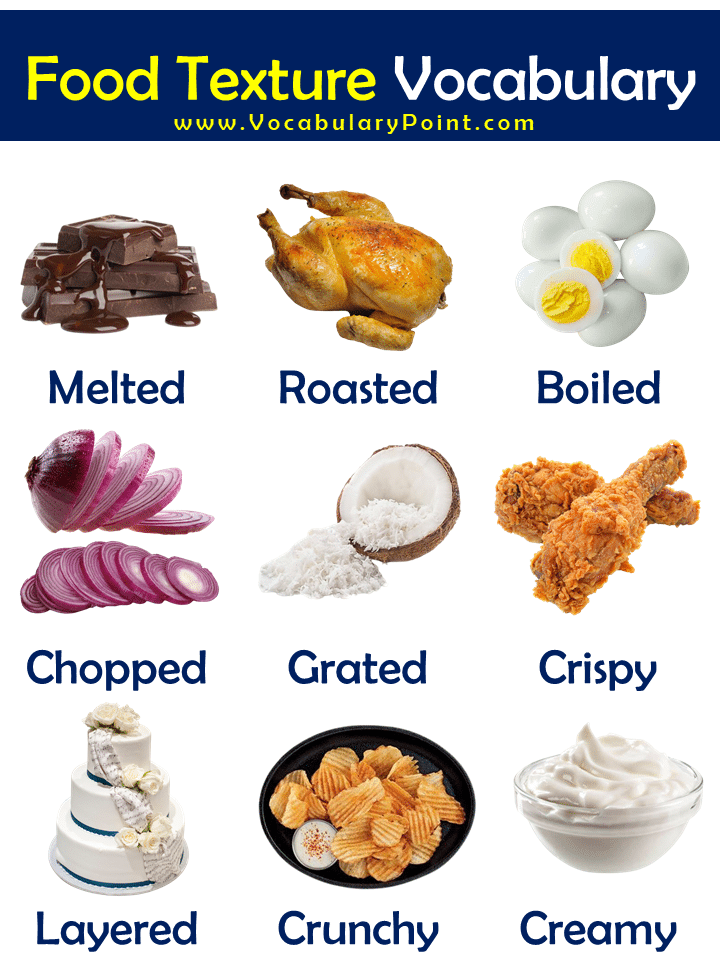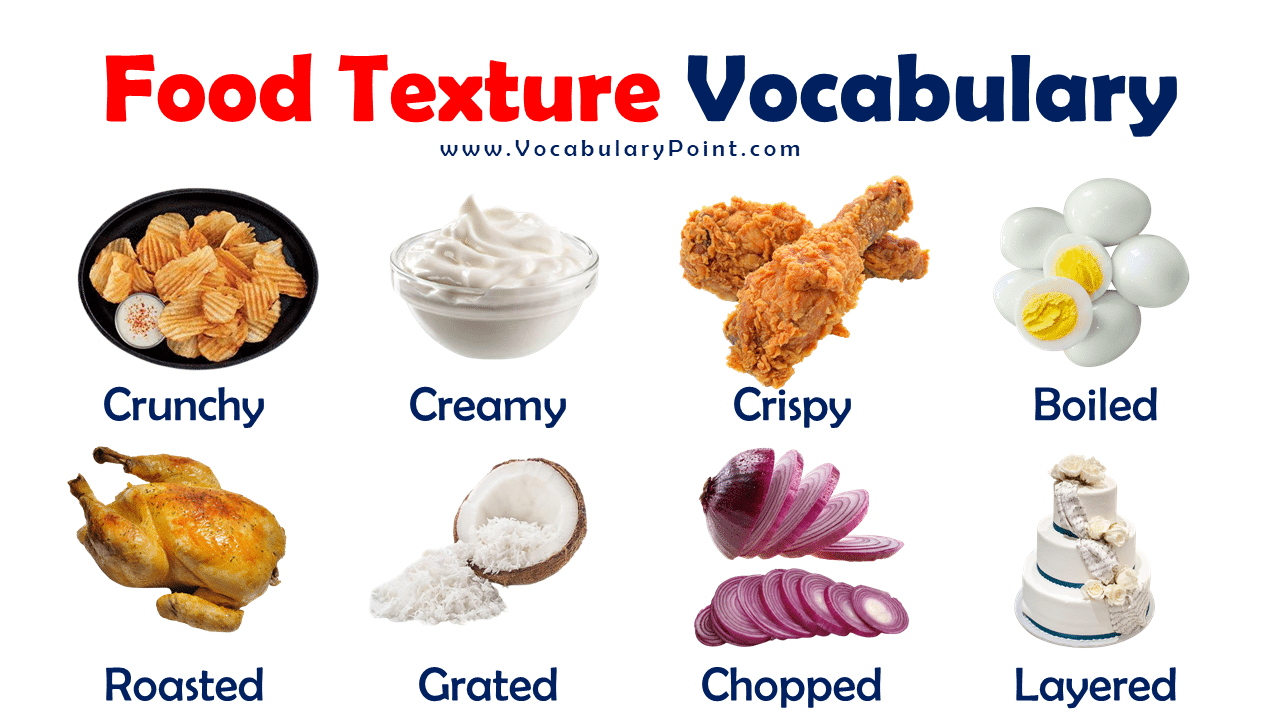What is Texture?
“Texture” refers to the physical feel or visual appearance of a surface or material. It can describe tactile qualities (like roughness, smoothness, softness, or bumpiness) or visual patterns that suggest such qualities. In various fields, texture adds depth, interest, or functional properties to objects, artworks, musical compositions, and culinary creations, affecting how they are perceived and experienced.
Food Texture Vocabulary
- Crunchy
- Smooth
- Creamy
- Crispy
- Chewy
- Gooey
- Silky
- Velvety
- Fluffy
- Spongy
- Firm
- Soft
- Moist
- Dry
- Juicy
- Gelatinous
- Sticky
- Slippery
- Grainy
- Brittle
- Tender
- Tough
- Hard
- Dense
- Airy
- Greasy
- Slick
- Gloopy
- Lumpy
- Mashed
- Pureed
- Whipped
- Glazed
- Fizzy
- Bubbly
- Frothy
- Crumbly
- Flaky
- Stringy
- Melted
- Icy
- Frozen
- Thawed
- Powdery
- Grated
- Shredded
- Minced
- Chopped
- Sliced
- Diced
- Pounded
- Moulded
- Layered
- Encrusted
- Coated
- Breaded
- Fried
- Sauteed
- Grilled
- Roasted
- Baked
- Boiled
- Steamed
- Blanched
- Simmered
- Braised
- Stewed
- Marinated
- Pickled
- Cured
- Smoked
- Charred
- Burnt
- Scorched
- Seared
- Caramelized
- Crystallized
- Emulsified
- Infused
- Soaked
- Sprinkled
- Dotted
- Swirled
- Layered
- Topped
- Filled
- Stuffed
- Garnished
- Drizzled
- Glazed
- Dusted
- Spattered
- Splashed
- Smeared
- Spread
- Piped
- Zested
- Flambéed
- Chilled
- Refreshed
Explore More:

Crunchy
A texture characterized by a hard, crisp surface that makes a loud sound when eaten, often found in fresh vegetables and crisps.
Smooth
Completely even texture; no bumps or roughness, pleasant to touch or taste, common in chocolates and creams.
Creamy
Thick, smooth, and soft, often rich in fat, providing a luxurious feel in the mouth, typical of dairy products like butter and cream.
Crispy
Thin and brittle, offering a sharp crunch when bitten into, ideal for chips and fried foods.
Chewy
Requires sustained chewing to break down, offering a firm yet elastic texture, often found in meats and certain candies.
Gooey
Sticky and thick, pulling away in strings or strands, characteristic of melted cheese or marshmallow.
Silky
Exceptionally smooth and fine to the touch or taste, similar to silk, common in custards and fine sauces.
Velvety
Soft and smooth, with a rich texture that feels luxurious in the mouth, often used to describe soups and purées.
Fluffy
Light and airy, with a softness that feels like cotton or clouds, typical of whipped cream and certain pastries.
Spongy
Soft and absorbent, with a texture that compresses and springs back, found in cakes and some breads.
Firm
Solid to the touch with some resistance, but not hard, common in well-set cheeses and some meats.
Soft
Easily yielding to pressure, not firm or hard, characteristic of ripe fruits and tender meats.
Moist
Containing a good amount of water or liquid, neither dry nor soggy, often used to describe well-cooked meat and baked goods.
Dry
Lacking moisture, can be hard or brittle, common in overcooked food and certain snacks like crackers.
Juicy
Full of liquid, offering a burst of flavor when bitten into, typical of ripe fruits and well-cooked meats.
Gelatinous
Jelly-like in consistency, wobbly and smooth, often resulting from cooking bones or used in certain desserts.
Sticky
Tends to adhere to surfaces or other objects, requiring effort to detach, found in syrups and candy.
Slippery
Smooth and wet, making it difficult to hold or grasp, common in cooked noodles and certain seafood.
Grainy
Composed of small, hard particles, feeling slightly rough, often found in poorly emulsified sauces or some whole-grain bread.
Brittle
Hard but easily broken or shattered, offering a sharp break, typical of hard candies and certain cookies.
Tender
Soft and easy to chew or cut, requiring little force, common in slow-cooked meats and ripe fruits.
Tough
Requires considerable effort to chew through, often due to high collagen content in meat or underripe fruits.
Hard
Very firm and resistant to pressure, not easily bitten into, characteristic of raw vegetables and nuts.
Dense
Heavy for its size, with a compact texture, often found in dense breads and rich cakes.
Airy
Light with lots of open spaces or bubbles, creating a feeling of lightness, typical of meringues and some breads.
Greasy
Covered with or containing a lot of fat or oil, often leaving a residue, common in fried foods.
Slick
Smooth and possibly oily to the touch, offering little resistance, common in foods with high fat content.
Gloopy
Thick and viscous, moving slowly and sticking together, characteristic of honey and thick sauces.
Lumpy
Contains small, hard pieces or balls within a softer material, often found in improperly mixed batters or gravies.
Mashed
Crushed or beaten into a soft, uniform mass, typically used for potatoes and other vegetables.
Pureed
Completely blended or processed to a smooth, often creamy consistency, common in baby food and soups.
Whipped
Incorporated air into, making it light and fluffy, typical of cream and egg whites.
Glazed
Coated with a thin, shiny, often sweet layer, enhancing appearance and adding flavor, common in pastries and ham.
Fizzy
Contains bubbles of gas, giving a tingling sensation, typical of carbonated drinks.
Bubbly
Characterized by the presence of bubbles, often indicating lightness and fizziness, common in sparkling beverages.
Frothy
Full of small bubbles, creating a light and foamy texture, often found in milkshakes and cappuccinos.
Crumbly
Falls apart easily into small crumbs, not holding together well, typical of shortbread and aged cheese.
Flaky
Layers that peel away easily, creating a light, airy texture, common in pastries and fish.
Stringy
Forms thin strands or strings when pulled apart, often found in certain cheeses and meats.
Melted
Changed from solid to liquid by heat, common in chocolate and butter.
